
D.Bayarkhuu, International relations researcher and professor
Following the visit of Prime Minister U.Khurelsukh to the Russian Federation, let’s discuss about the important domestic topic of the gas pipeline. Mentioned below are rather the opinions of professional engineers and researchers, and not my personal perspective.
Studies show that Mongolia is abundant in methane reserves in comparison to the rest of the world. According to my physicist friend, Mongolia’s gas reserves are 600 times more than China’s. If used correctly, Mongolia can compete with not only Russia, but the rest of the world. If we extract methane from Tavan Tolgoi, and export them to China, we can compete with Russia. It will be too late for Russia to let alone stop, but to even delay it. To not let Mongolia use the reserve, we must not ignore the political speculation that Russia is supplying natural gas through Mongolia to prevent us from exporting to our third neighbors. They say that Mongolia is abundant in the impressive raw material of oil shale. It is very easy to produce gasoline. There are talks that say Russia delayed Mongolia from mining oil shale. However, we are not here to discuss the accuracy of this information, and I apologize for including such hazy information.
Let’s get back to the topic. Where will Russia place the natural gas pipes that export to China? They are most likely already aware of the specific provinces that will be the most beneficial for them to place the pipes through, ones that could also consume the product. Like the saying, even a drop of water contributes to the sea, comprehend the information as a foundation and study further to your linking.
1. There is a general understanding of the gas pipes going to Russia and China through three main routes. Going east from Lake Kovykta via the Power of Siberia pipeline to the northwest of Lake Baikal, and connecting another gas pipeline from Yakutia to the city of Blagoveschensk on the Amur River, from there to the northeast of China, and then to the central provinces of China.
2. The second route is the one that we like to possess. The Kovykta deposit is located in the Irkutsk region on the western shore of Lake Baikal. From there, it heads through Irkutsk, and Ulan-Ude to enter Mongolia. This route opens up the option for accessing China via Zamiin Ude, passing through Khiangte-Altanbulag pipeline and moving along the railway.
3. The third route is an alternative that I am proposing to make it more relevant for Mongolia. It is the talk of the pipeline passing from Russia through west Mongolia to Xinjiang. This piece will further elaborate on this.

Gazprom Barnaul, a large state owned company operates in the Altai territory. The project to export to China’s Xinjiang is available there. This leads us to the question “Why is the project not operating despite 10 years passing since the proposal?”. There is muslim extremism and terrorism being a threat in the region. Geopolitics and military strategists say that the project is likely at risk. China has not made any official statements regarding such a threat. If there is a risk for direct entry from Altai to Xinjiang, the two neighbors know that Mongolia is an alternative scenario as well. Russia and China are more concerned about the natural and geographical obstacles that cross the Altai Mountains, rather than the danger of Muslim extremism and terrorism. The attempt for the pipeline was experimented more than once. However, it is impossible to make the pipeline above the snowy mountain ranges.
In a scenario where we lack the technology to penetrate the Altai Mountains, it is possible to draw a pipe from Barnaul to Biysk and then bring it from Tuva to Tsagaan nuur valley of Bayan-Ulgii province at the discretion of the relevant parties. Though it is possible to build the pipelines along the railroads, it is questionable whether this will actually be carried out. Now, the railway from Biysk to Tuva is being laid. The gas from Russia can be channeled through the 400 km pipeline to Tsagaanuur and only 216 km through Mongolia to Xinjiang. No other province than Bayan-Ulgii will be included. The destination it is to reach in China is Karamay, Xinjiang. It is a small and oil refining town. With the gas coming in from Russia, the city will become a major energy hub.
The second way to reach the western provinces is to cross over to Khovd from Bayan-Ulgii to Xinjiang, and then from Khovd to Karamay. This will increase the length of the gas pipeline that goes through Mongolia, increasing jobs, infrastructure and energy in the western provinces. As for Xinjiang, it lays the foundation for a long development plan. The continent wide railway is in a sense, a new silk road and greatly saves the time it takes to transport goods from Asia to Europe. An important region in this is Xinjiang. Once there is a transport network, infrastructure will be built and the western provinces will be connected. This advances the potential for development in Mongolia further.
As for the third scenario, it is one that passes through the three western provinces and leads to China through Govi-Altai. Hopefully, the Mongolian decision makers take this into consideration seriously. May Mongolia be the strong force that moves the large natural gas projects Altain Hyazgaar- Tuva- Bayan-Ulgii- Khovd- Govi-Altai-Gansu.
One may wonder as to why the Gansu Province is mentioned at all. It is a province in northwestern China. The total population is 25 million and the capital city is Lanzhou. The only country it borders is Mongolia and the province is the largest center in China’s petrochemical industry, and is one of the most important centers of the world`s renewable (wind) sources. Govi-Altai Province borders 60 km with the Gansu Province. The Chinese high-speed train line passes 60 kms from Gansu. The world’s longest high-speed railway built in the high grounds of China Lanzhou-Xinjiang special line Gansu- Hohnuur is operating, passing through Gansu- Hohnuur- Xinjiang Province crossing the total length of 1776 kms. Simultaneously, the railway from Inner Mongolia’s Ezanee Province to Xinjiang Hamil was commissioned. This facilitates the export of goods and merchandise from western Xinjiang-Gansu- Inner Mongolia. In comparison to the previous Lanzhou-Xinjiang and Bugat-Lanjou Railways, this route is 400 kms shorter. The eastern part of this grand network is the Tianjin port, whereas the western point is the mouth of the Alag Mountain, the second shortest route from Asia to Europe. The fact that China is studying a new route to connect landlocked Mongolia to the sea is of particular concern to our state.
It is believed that electricity can be distributed in many regions of China, both to the east and south through the Gansu corridor. Thus, why should Mongolia try to get involved in such a gas project to create regional development pillars and develop the three western provinces?
Listed above are three possible corridors. The fourth, or the most important route is the scenario passing from Naushki-Khiang to the south through Altanbulag to Zamiin Ude. This is what is currently being discussed by the authorities. Hopefully, the results will be positive. The same applies to the connection of the “Three Reds”. The fifth may be the Chita-Erentsav-Choibalsan direction, branching further from Power of Siberia pipeline. If the two neighbors want, this can be easily constructed as well.
If the government grabs on to routes as such and makes the move, there is no such thing as not possible. They only need to take the initiative to make it happen.
